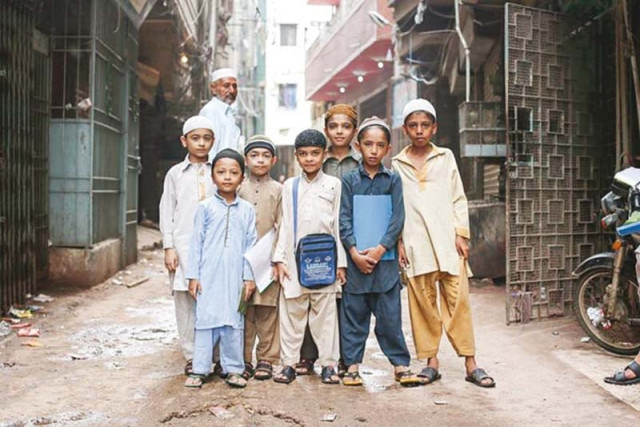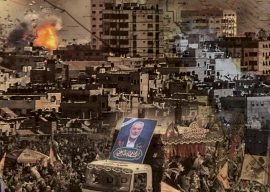
 Brandon Stanton and his interpreter Haya Fatima Iqbal smile for a selfie.
Brandon Stanton and his interpreter Haya Fatima Iqbal smile for a selfie.“People must have been laughing seeing a foreigner with a camera and a screaming local chasing a young woman smack in the middle of one of Karachi’s busiest roads,” says Haya Fatima Iqbal, a 28-year old film-maker who partnered with Stanton as his interpreter during his trip to Pakistan.
Last September, Stanton travelled to 11 countries in collaboration with the United Nations, to raise awareness of millennium development goals. At the end of July this year, he announced that he would be travelling to two countries — Pakistan and Iran.
While the message was received with squeals of joy from HONY’s followers in Pakistan, many did not know at the time that Stanton had already visited the country and left by the time the first photograph — from Hunza — was posted on Facebook. “It was simply a precautionary measure,” Iqbal explains, as Stanton’s project required the ability to move freely and talk to strangers — a feat that would have been near-impossible had the media tailed him. “Having a media crew around Brandon would have only made the situation awkward and I don’t think people would have opened up to him in that scenario.”
Mystery man
At sehri on July 14, an intriguing email landed in Iqbal’s inbox. A journalist in New York, Fazeelat Aslam, had passed Iqbal’s email address on to Stanton, suggesting that she may be able to help him find an interpreter. Iqbal knew she had to pitch herself for this incredible opportunity. “I wrote to him about my experiences as a film-maker and how people have opened up to me on camera and told me things that they have never spoken to anyone about,” Iqbal recalls. By iftari, Iqbal and Stanton were ironing out details of his trip.

 At times, Stanton and Iqbal worked for more than 12 hours a day in search of stories.
At times, Stanton and Iqbal worked for more than 12 hours a day in search of stories.“Brandon was sure about visiting Gilgit and Lahore,” Iqbal says. “I talked to him about the Karachi-Lahore rivalry and explained that he could not visit one city and not the other.” Five days later, Stanton arrived in Pakistan, but Iqbal could not tell anyone. “It was very difficult for me to not post a selfie I had taken with Brandon, but I was willing to take the secret to my grave,” she quips.
Finding ‘Humans’
The journey started from Lahore, onwards to Karachi and finally, Hunza — the exact opposite of the sequence of the pictures posted on the HONY page.
Describing Brandon’s style of exploring, Iqbal shares how during a trip to the Walled City of Lahore, he told the driver to stop right at the entrance. “We walked for quite some time, far away from the car, observing the surroundings. When he felt he wanted to take someone’s picture, he would ask me, ‘How about him?’” Haya says.

 The HONY community raised more then $2million to free bonded labourers in Pakistan.
The HONY community raised more then $2million to free bonded labourers in Pakistan.Iqbal would initiate conversations with the chosen man or woman and explain Stanton’s project. The majority of people they approached were not Internet-users, she says, and mentioning the word ‘Internet’ would prompt concerned queries. In some cases, Iqbal would show their chosen subject the HONY page on her mobile phone. “We had this pakka rule that if someone hesitates, let them go,” Iqbal explains, as the pair decided they did not want to convince anyone to have their photograph taken. She worried about the number of rejections they were receiving, but Stanton reassured her, saying, “I get rejected in New York all the time.”
“We came across many people who did not understand the work but when they realised Brandon was visiting from a foreign land, they would say things like, ‘Chalain aap humaray mehmaan hain, ley lain picture (Since you are our guest, you can take a picture)’,” she recalls.
On average, the pair approached 30 to 35 people every day and often worked 12-hour days, with an average of 10 to 15 good stories every day. Iqbal says Stanton was not recognised during his trip. “Only three people in Karachi knew who he was,” she says, recalling an instance when Stanton approached a girl for her photograph, she knew about HONY, but had no idea who he was.
Iqbal recalls that while on the lookout for potential stories, she would keep an eye on the surroundings. “Many times, I was Brandon’s unofficial bodyguard or food inspector,” she says, laughing. The HONY founder was not immune to Karachi’s delicious food, but unfortunately suffered a bout of food poisoning and had to make do with khichri and yogurt. Iqbal recalls that Stanton was not overwhelmed by the city. “I’ve seen so many near-accidents happening on the roads here, yet everyone just seems to be laughing at the situation and moving on,” he had said to her.
Through a foreign lens
While Pakistanis took pride in all the beautiful stories Brandon was rolling out on HONY’s platforms, fans around the world thanked him for bringing the largely unreported side of the country to the forefront.
One story, encapsulated in seven photographs, from Lahore in particular resonated with HONY’s audience. Thousands donated to Syeda Ghulam Fatima’s Bonded Labour Liberation Front when Stanton told her story. “Fatima has devoted her life to ending bonded labor. She has been shot, electrocuted, and beaten numerous times for her activism,” Stanton wrote on his Facebook page, along with testimonies of bonded labourers working at brick kilns in the country. To date, a campaign to support Fatima’s activism has raised more than $2.3 million.

 HONY fans thanked Stanton for the Pakistan series as it helped many think beyond stereotypes
HONY fans thanked Stanton for the Pakistan series as it helped many think beyond stereotypes“Brandon’s pictures of Pakistan show life in its random, abstract form,” Iqbal explains. “There are heart-warming stories of family and love and on the other hand you have tales of eviction, illness and poverty.” Iqbal specifically mentions one photograph taken in Karachi of a middle-aged man who shared how he took care of his ailing wife during her last days. “The photograph shows a man relaxing on a charpoy in a very masculine posture, yet his story shows an entirely different side to his personality,” she explains. “All these stories reinforced my belief that you should never judge a person by the way they look or where they live — andar say kuch bhi nikal sakta hai (It can be anything from inside).”
Personal favourite
Iqbal says it is difficult for her to choose her favourite photographs from Stanton’s collection of 70 images of Pakistan, but she is proudest of the images from Lyari in Karachi. “In my own work, I have tried to show that Lyari should not be known just for its security problems, and HONY’s pictures reflected that.” Stanton’s last photograph from the series in Pakistan was an image of children in Lyari. “That was a perfect message to end the series,” Iqbal feels. “For me, it was a double whammy of happiness.”
Iqbal praises Stanton’s humble nature, saying it provided the impetus to create photographs that emotionally connected with millions. “Imagine, seven photos collecting $2 million,” she says, referring to the images of bonded labourers. “That did not happen just because Brandon is famous but because people trust him. He doesn’t think of himself as a celebrity. He is down to earth and that is exactly why his work is great.”
Ferya Ilyas is a senior subeditor at The Express Tribune. She tweets @ferya_ilyas
Published in The Express Tribune, Sunday Magazine, August 30th, 2015.


















COMMENTS
Comments are moderated and generally will be posted if they are on-topic and not abusive.
For more information, please see our Comments FAQ